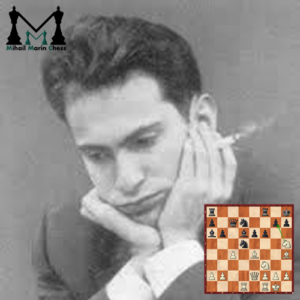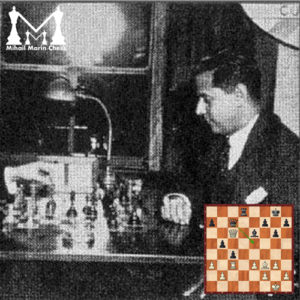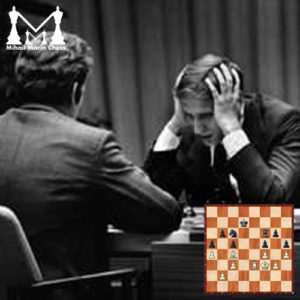
Long time ago, an experienced trainer told me that the individual games played over the years between players who meet frequently over the board should be regarded as parts of an endless match. The opening choice, the general approach and optimism level greatly depend of the previous results. There are periods with favorable or unfavorable trends for both player and each of them should aim at maintaining (or, respectively, changing) it.
The game below was the first encounter between Goryachkina and Ju Wenjun after their World title match played earlier this year. On that occasion the Chinese player managed to retain her title but due to Goryachkina’s progress over the past years one would expect her to get another shot at conquering the crown in the next cycle.
From this point of view, their recent match can be regarded as only part of a long term rivalry and the game played in Lausanne could also have an impact over each player’s state of spirit in the future. Had this game been played then, it could have been easily considered the best game in the entire match.
Goryachkina (2579) – Ju Wenjun (2583) [D35]
Lausanne FIDE GP (W), 12.03.2020
[Marin]
1.d4 Nf6 2.c4 e6 3.Nc3 d5 4.cxd5 Nxd5 5.e4 Nxc3 6.bxc3 c5
Once a favorite of players like Fischer and Kortschnoj, for instance, the Semi Tarrasch has once again become popular over the past decade, partly due to Kramnik’s efforts.
7.Nf3 cxd4 8.cxd4 Bb4+ 9.Bd2 Bxd2+ 10.Qxd2 0–0 11.Bc4 Nd7
This is the modern trend and the line I have examined on my DVD dedicated to this opening.
Anticipating White’s later positional pawn sacrifice it is worth mentioning a classical game where the same operation proved lethal. 11…Nc6 12.0–0 b6 13.Rad1 Bb7 14.Rfe1 Rc8 15.d5 Na5 16.Bd3 exd5 17.e5 Nc4 18.Qf4 Nb2
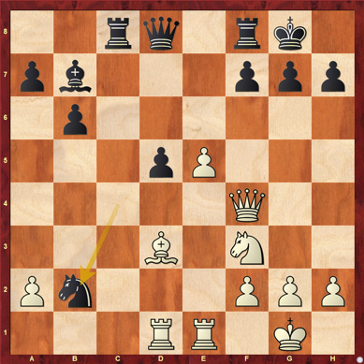
19.Bxh7+! Kxh7 20.Ng5+ Kg6 21.h4 with an almost decisive attack in Polugaevsky-Tal, Moscow 1969 (1–0, 37) Remarkably, Polugaevsky was still following his home analysis at this height.
12.0–0 b6 13.Rad1 Bb7 14.Rfe1 Rc8 15.Bb3 Re8 16.h3 h6
Black’s developing is more flexible than in the quoted game, but the positional threat d4–d5 remains valid. With her next moves, White strengthens her control in the center to the maximum before delivering the central blow.
17.Re3 Nf6
Judging from the time spent on each move, it is only now that the players were on their own. Earlier they played fast, probably just following their preparation.
18.Qe2 Rc7

19.d5!
After nine minutes Goryachkina decided there was no way of improving her position even more. With such thoughts in mind, one does not have to check the consequences of the central break in detail. It cannot be bad and if it does not offer a concrete advantage, too bad!
19…exd5 20.e5 Nh5!
Ju Wenjun played this strong move after 22 minutes. This is the best square for the knight, offering the most effective possibility of a quick transfer to the e6–square.
20…Ne4? loses to 21.Rxe4; 20…Nd7 21.Nd4 Nc5 22.Nf5 offers White a dangerous attack.
21.Rd4
This hyper-active major piece display, preventing …Nf4, also has some minor drawbacks. In principle the best blocking piece is the knight and at the same time the back rank remains undefended now.
21.Nd4 is less effective now as Black can gain time with 21…Nf4 22.Qf3 (22.Qg4 Qg5 is safe for Black.) 22…Ne6.
21…g6
Opening another transfer route to e6.
22.Qd2 Qe7
Most likely, an over the board novelty played after 17 minutes.
The only game reaching this position went 22…Ng7 The knight hurries to e6 or maybe f5. 23.Bxd5 Qa8?! (Safer was 23…Bxd5! 24.Rxd5 Qc8 and Black is likely to maintain his stability.) In Illescas-Comas, Merida 2005 (1–0, 32) White’s strongest move would have been 24.Bb3! keeping the dangerous bishop. 24…Bc8 (Trying to neutralize the enemy bishop anyway. 24…Nf5 allows 25.e6! Nxd4 26.Nxd4 with a decisive attack.) 25.Red3 Be6 26.Rd8 Qc6 27.Qxh6 with a sound extra pawn.

23.Nh2!
A logical way of developing the kingside attack.
23…Qc5!
Black has to generate some queenside counterplay before she gets crushed on the opposite wing.
24.Re1 Qc3 25.Qd1
An elegant double retreat, maintaining the tension.
25…Rec8 26.e6
The most threatening move order, as if 26.Ng4 Qc1 Black is doing fine.
26…Nf6
Taking measures against Ng4.
26…Qc1 fails to neutralize White’s initiative: 27.exf7+ Kg7 (27…Kxf7? 28.Qf3+ wins the queen.) 28.f8Q+ Kxf8 29.Qe2 with dangerous threats against the exposed king.
27.Ng4 Nxg4 28.Rxg4 Kg7 29.exf7
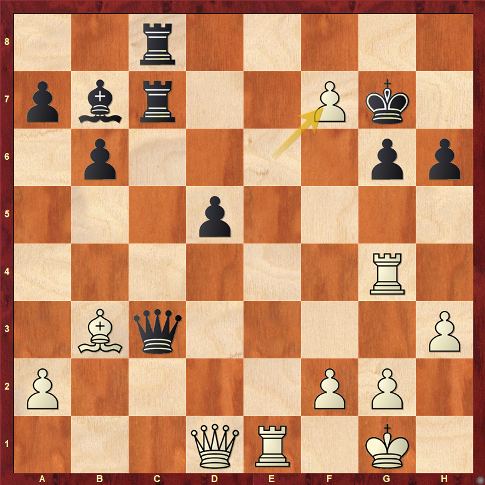
Attack and defense have matched each other so far, but the World champion makes a small concession now.
29…Rxf7?!
In vain allowing the next rook intrusion. Safer was 29…Qf6!? with approximate equality.
30.Re6 g5 31.Kh2!!
A fantastic prophylactic move, avoiding the back rank pin and reminding of a famous classical game:
Kasparov-Karpov, London/Leningrad (m/16), 1986
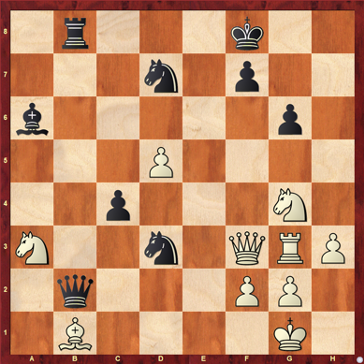
At this height Black’s queenside counterplay looks much faster than White’s kingside attack. Besides, Karpov had an enormous advantage on the clock. But the calm 31.Kh2! ensured White against problems. One of the main ideas is to threaten Nh6 without fearing …Qc1+. Karpov completely lost orientation and ended up losing. As a funny coincidence, it is all about anticipating …Qc1 in both cases.
Back to our main game. Deprived of the possibility of exchanging queens, Black starts experiencing real problems now.
31…Qc7+
31…Qc1? allows 32.Qd4+ at full strength.
32.Rg3 Rcf8 33.Qd4+
33.Qa1+ is an important alternative, maintaining the back rank defended. 33…Rf6 34.Kh1! Another strong move, unpinning the rook. This is effective only with the queen on the back rank as otherwise …Qc1 would force a move repetition. 34…Bc8 (34…Kg6 35.Rge3 is dangerous) 35.Rxf6 Rxf6 36.Bxd5 with lasting pressure.
33…Rf6 34.h4
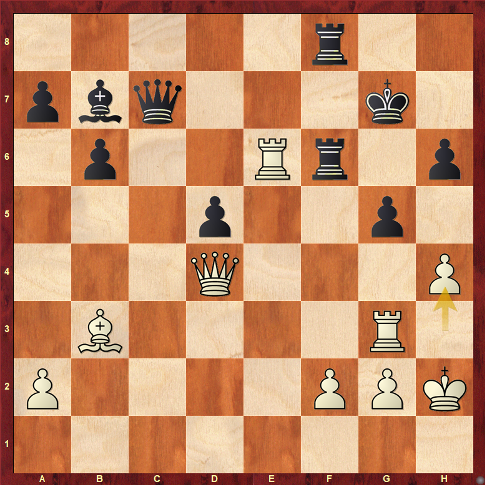
34…Qc5?
The decisive mistake. Black should have used her first and only chance to force the queen exchange with 34…Qf4 even though this basically loses a pawn: 35.Qxf4 Rxf4 36.hxg5 hxg5 37.Rxg5+ Kf7 38.Rge5 Rxf2 39.Re7+ Kf6 It appears that for the time being the bishop is taboo. 40.Kg1! Rb2 41.R5e6+ Kf5 42.Re1! Attacking the bishop and threatening Rf1+. 42…Ba6 43.Rxa7 Bd3 44.Bxd5 with some practical chances for White.
35.Qe5
The game is over now.
35…d4 36.hxg5 hxg5
If Black relied on 36…Qxe5 she must have overlooked that 37.gxf6+ is a double check!
37.Rxg5+ Kh8 38.Rh5+ Kg7 39.Qg3+
1–0


